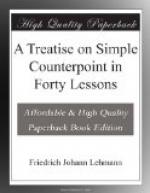[Illustration: Fig. 45.]
The fifth, when in the lower part, may be used on any but the first quarter, provided it is treated as a passing-tone, e.g., approached and left by stepwise progression in one direction.
[Illustration: Fig. 46.]
Consecutive fifths and octaves are forbidden when appearing on the accented beats of successive measures; between prominent notes of successive measures not more than four quarters apart; and between a prominent note of one measure and the first quarter of the next. [Fig. 47.]
[Illustration: Fig. 47.]
Oblique motion to the unison is bad. It is permitted if it continues in the same direction through the unison. [Fig. 48.]
[Illustration: Fig. 48.]
The unison may be used on any but the first quarter of a measure.
Frequent repetition of a figure as in Fig. 49 is not good.
[Illustration: Fig. 49.]
The embellishment may be used either above or below, whether a semitone or a whole tone; but when it is a whole tone below, it is most satisfactory as the ninth of the implied chord. [Fig. 50.]
[Illustration: Fig. 50.]
In minor the sixth and seventh degrees of the scale are raised both ascending and descending, when used in harmonies containing the leading-tone as a chord-tone. They are unaltered both ascending and descending in harmonies containing the sixth degree of the scale as a chord-tone. In other harmonies they are raised in ascending only.
The sixth or seventh degrees may be chromatically altered with only one note intervening. [Fig. 51.]
[Illustration: Fig. 51.]
Six notes may be written to one of the cantus firmus, as in Fig. 52.
[Illustration: Fig. 52.]
The cadences in Fig. 53 are good.
[Illustration: Fig. 53.]
EXERCISES
To cantus firmus a write three counterpoints above and three below, in the third species.
Write two eight-measure phrases, using second species continuously in both parts. [Fig. 34.]
CANTUS FIRMUS
[Illustration: Fig. 54.]
LESSON V
THIRD SPECIES IN BOTH PARTS
[Illustration: Fig. 55.]
The suggestions given for writing second species in both parts apply here, except that when both parts move degreewise, any interval may come on the second and fourth quarters, preferably a consonance. The third quarter is treated the same as the second half when writing the second species in both parts.
The augmented fourth, and diminished fifth and seventh, may be approached in similar motion. [Fig. 56.]
[Illustration: Fig. 56.]
The augmented fourth following the perfect fourth, as in Fig. 56_a_, is good.




